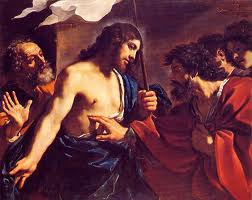
But Thomas said to them, “Unless I see the mark of the nails in his hands, and put my finger in the mark of the nails and my hand in his side, I will not believe.” (See John 20:19-31 NRSV).
Let’s not be so quick to judge Thomas’ faith. He like the other disciples were grieving the death of their best friend. His hopes were dashed to pieces. Can we blame him for being so skeptical about this news that the Risen Christ appeared to them? Thomas wanted more than just the word from the others. He wanted to know for himself that if Christ rose from the dead, will Jesus be able to help Thomas see that God understood how wounded Thomas was.
Jesus rose from the dead with our wounds on his body. Our wounds in God’s power to raise Jesus from the grave had been redeemed and rendered powerless. Thomas experienced God’s healing of his faith. Jesus showed him that God had taken his wounds seriously. God loved Thomas and all of us so deeply, that Jesus offered our wounds to God so,that they could be transformed in the Resurrection.
A contemplative knows that we have wounds. The wounds and pain will change our lives. We will be challenged in our faith. The mysticism of the Resurrection is that God shows us that our wounds can go to the very heart of God, who will love us and walk through them with us. Our wounds are an opportunity to strengthen our faith by drawing closer in relationship to God through the death and Resurrection of Christ.
May we with Thomas dare to ask the Risen Christ to affirm and heal our faith by touching Jesus’ wounds and cry with Thomas, “My Lord, and my God.”
“Let them prefer nothing whatever to Christ, and may he bring us all together to everlasting life.” (RB 1980: The Rule of St. Benedict in English, p.95).
Amen.
Peace be with all who enter here.
Brother Anselm Philip King-Lowe, OSB
If you or someone you know could benefit from Spiritual or Grief Companionship, visit my website here to find information about my ministry.
If you feel led to buy me some coffee, please scroll down to the bottom of the right sidebar and click on the Benedictine Coffee Mug. Thank you so very much.